A lot of trees are blooming in Hugh Ramsey Nature Park and it’s an exciting time of year because not only can you begin to learn to recognize trees, you get to see where they are in the park.
So, you’re walking along Ebony Loop in the park and a flash of purple and yellow colors snag your attention. You do a double take and then back up. Peeking out of a snarly, brambly thicket of thorns and dead tree limbs is something you recognize. “Wow,” you exclaim. “Here’s another Guayacán!” We know this because there is a big, beautiful specimen at the trail head with a sign in front of it.
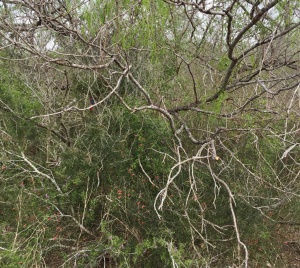
Because it’s hard to keep up with nature, many times while we’re working in Ramsey Park we discover trees that might need rescuing from their surroundings. Some trees, such as Guayacán, aren’t as prevalent in the park, as say, mesquite and granjeno.
Those rare-to-the-park trees we try to showcase by rescuing them from aggressive growth that in time would overpower them while the faster-growing and more aggressive trees fight for nutrients and sunlight.
The other day, Louise Wilkinson and I took on the Guayacán rescue. Louise and I met at TMN school and became friends and weeding buddies. We’re both on the Thursday morning Ramsey Park volunteer detail.
We work well together because we’re Goal Oriented – no snarly mess has a chance with us.
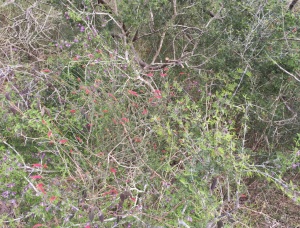
We used a ratcheting lopper, a pair of hand clippers and a small hand saw — good shoes and thick gloves were in the mix, too, of course and long sleeved shirts. Granjeo and mesquite have thorns.
We first cleared dead mesquite tree branches from the top of the small Guayacán. Next we pulled dicliptera and dead mallow stems from around the base — that gave us access to the other side of the shrub where a many-trunked granjeno had twined itself through the Guayacán. We sawed off the granjeno and doused the stumps with stump killer.
Finally the Guayacán had some breathing room.
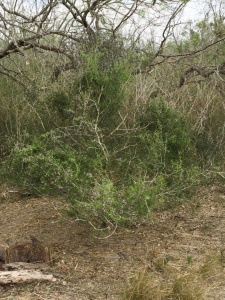
Our work wasn’t quite done.
As one of us pulled, sawed and lopped, the other chopped branches and debris into sizable piles. We traded off occasionally in a seamless effort.
The final task was to stash the debris away from the path.
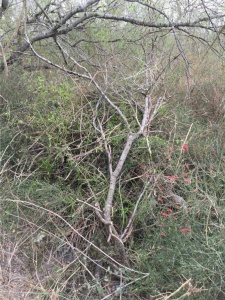
Yes, if you’ve known me for any length of time, I’m a die-hard brush pile advocate. (Read my blog “Brush Piles,” February 2015)
As I will continue to say, probably forever, debris left on trails for city pick-up go to the city landfill and provide no nutrients for the forest floor and eventually raise taxes when landfills fill up and household waste has to be trucked distances.
When possible, brush piles are less unsightly when relatively hidden from the footpath.
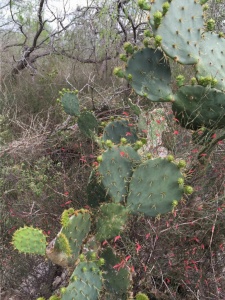
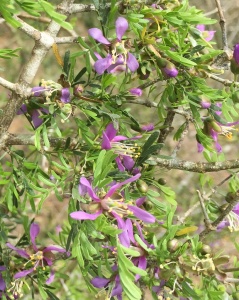
March is the month to go to a nature park or take a nature tour where you can see all the glorious color. We’re giving Ebony Loop nature walks every Friday through April 1 beginning at 9 a.m. and lasting about two hours. Rain cancels.
I gave a private tour last week to some new Winter Texans and managed to keep note of what is blooming around Ebony Loop. I won’t give scientific names, but the numbers behind each plant name refer to the page number in the Richarson/King book, “Plants of Deep South Texas.”
Capraria – 385
Huisache – 240
Wild Olive – 141
Amargosa – 390 — delicate peach-colored blooms against wicked thorns
Baby Bonnets – 255
Bailey’s Ball Moss – 28
Yellow Sophora – 270
Black Brush – 241 — Amazing collection of awesome catkins
Pata de Chivo – not in book
Texas Mountain Laurel – 270
Palo Verde – 235 — Mass of yellow, miniature orchid-like blooms
Dicliptera – 49 – this you’ve got to see – blooms don’t stay long! (See Anita’s Blog, “Dicliptera Would Make a Good Spy,” November 2015)
White Mistflower – 98 — wait ‘til you smell this — Heavenly
Red Poppy (white-flowering form – 345 — Don’t touch – pricklier than a Prickly Pear Cactus
Thousands of buds on Colima so far and a lot of butterfly species already dashing about the trail.
Hugh Ramsey Nature Park is at 1000 South 499, just two miles south of Harlingen’s Valley International Airport. Reservations are encouraged in order to have enough guides for an optimum experience. Call 956-748-3190. Or e-mail rgvctmntreasurer@gmail.com.
Taking the tour will give you two hours of Advance Training time.

Leave a Reply